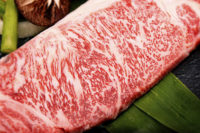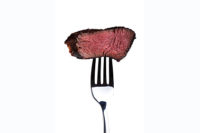 Because of weather conditions, beef cattle often experience periods of inadequate nutrition while grazing native range. Many times this period of under-nutrition coincides with some point in gestation. Alterations in nutrient flow to the fetus can potentially have permanent effects on physiology and growth of the offspring (Godfrey & Barker, 2000), which is called fetal programming.
Because of weather conditions, beef cattle often experience periods of inadequate nutrition while grazing native range. Many times this period of under-nutrition coincides with some point in gestation. Alterations in nutrient flow to the fetus can potentially have permanent effects on physiology and growth of the offspring (Godfrey & Barker, 2000), which is called fetal programming.
Gestational under-nutrition has been shown to increase adipose tissue deposition in livestock species (Bispham et al., 2005; Edwards et al., 2005). However, a limited amount of research has focused on maternal energy restriction during mid-gestation in beef cattle, a period when both muscle and fat development are occurring (Du et al., 2010). Impacts to these developmental processes could lead to alterations in fat and muscle tissue growth, animal performance, carcass characteristics and meat quality of beef offspring.
Therefore, the objective of this study was to determine the effects of maternal nutrient restriction during mid-gestation on growth performance, carcasscharacteristics and meat quality attributes in the resultant offspring. To accomplish these objectives, 151 beef cows were equally divided to one of two treatments, either to maintain body condition or to lose one body condition score during mid-gestation. The resultant progeny were followed from calving through harvest, where body weights, feedlot performance, carcass characteristics and full strip loins were collected for meat quality analysis.
The results show that birth weight was decreased in energy-restricted heifer calves compared to all other groups. There were no differences between treatments during the receiving period on growth performance. However, body weights at days 28, 56, and 85 of the feeding phase were decreased in the energy-restricted progeny compared to the control group. There were no differences between treatments for subsequent weights, or growth performance characteristics. There were also no differences in hot carcass weight, dressing percent, 12th ribfat thickness, ribeye area, percent kidney pelvic heart fat, Quality Grade, L*, a*, b* (color measurements) or Warner-Bratzler shear force. However, energy-restricted progeny had lower numerical yield grades, and an increased ratio of marbling to subcutaneous fat.
Collectively, we learned that cows that lost approximately one body condition score during mid-gestation can still produce offspring that can compete with offspring from cows that did not lose condition. In addition, energy restriction imposed on cows during mid-gestation actually resulted in offspring that had a more favorable distribution of carcass fat.
*Editor’s Note: Dustin Mohrhauser, Ph.D. candidate, South Dakota State University; Keith Underwood, assistant professor/extension specialist-Meats; Robbi Pritchard, distinguished professor; Amiee Wertz-Lutz, associate professor - Ruminant Nutrition; and Amanda Weaver, assistant professor - Meat Science, also contributed to this article.
References:
Bispham, J., D.S. Gardner, M.G. Gnanalingham, T. Stephenson, M. E. Symonds, and H. Budge. 2005. Maternal nutritional programming of fetal adipose tissue development: Differential effects on messenger ribonucleic acid abundance for uncoupling proteins and peroxisosome proliferator-activated and prolactin receptors. Endocrinology 146: 3943-3949.
Du, M., J. Tong, K. R. Underwood, M. Zhu, S. P. Ford, and P. W. Nathanielsz. 2010. Fetal programming of skeletal muscle development in ruminant animals. Journal of Animal Science 88:E51-60.
Edwards, L. J., J. R. McFarlane, K. G. Kauter, and I. C. McMillen. 2005. Impact of periconceptional nutrition on maternal and fetal leptin and fetal adiposity in singleton and twin pregnancies. American Journal of Physiology: Regulatory Integrative Comparative Physiology 288: R39-45.
Godfrey, K.M. & D.J. Barker. 2000. Fetal nutrition and adult disease. The American Journal of Clinical Nutrition 71:1344S-1352S.




Report Abusive Comment